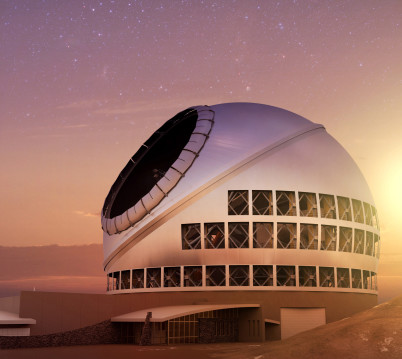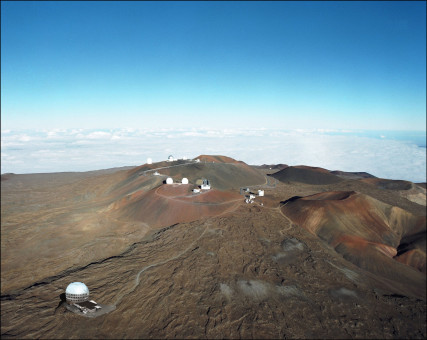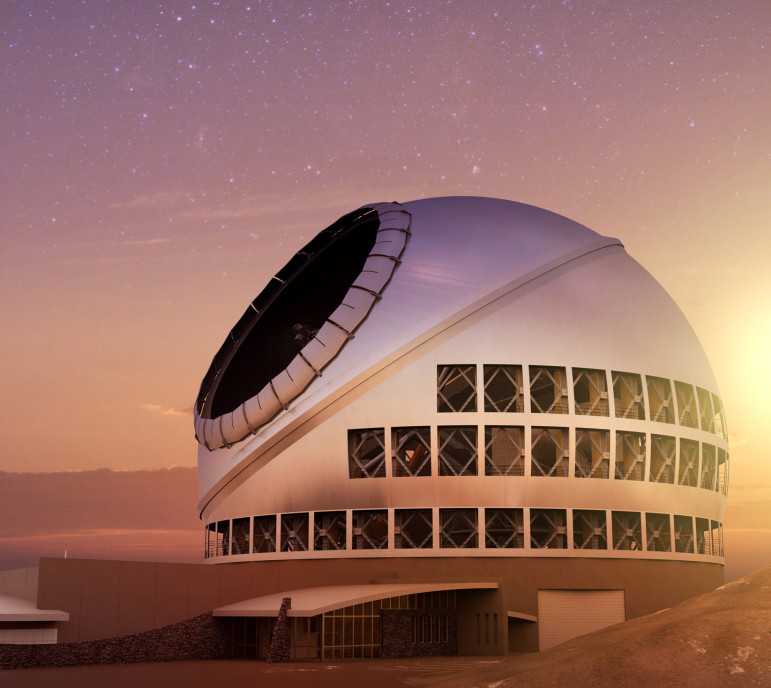
An artist’s rendering of the Thirty Meter Telescope at sunset. Source: http://www.tmt.org/gallery/photo-illustrations
The Supreme Court of Hawaii has declined a permit for the new Thirty Meter Telescope (TMT) observatory on Mauna Kea, the volcanic mountain on the Big Island. Unfortunately, some see this as “superstition” thwarting science. It’s really about due process and indigenous rights.
The TMT is an $1.4 billion international project that seeks to add a new observatory on Mauna Kea. Any construction on Mauna Kea is controversial because the mountain holds significant cultural and religious importance in native Hawaiian culture. The mountain is considered the temple of the Supreme Being, home of divine beings, and the place where Mother Earth meets Father Sky.
But what right do native Hawaiins have in opposing development on Mauna Kea because of its cultural and religious significance? The Hawaii Constitution explicitly protects the rights of those descended from native Hawaiians:
The State reaffirms and shall protect all rights, customarily and traditionally exercised for subsistence, cultural and religious purposes and possessed by ahupua’a tenants who are descendants of native Hawaiians who inhabited the Hawaiian Islands prior to 1778, subject to the right of the State to regulate such rights.

An artist concept illustrating the TMT Observatory at the proposed site on Mauna Kea. Source: http://www.tmt.org/gallery/photo-illustrations
This portion of the constitution does not give native Hawaiians exclusive control over the mountain. It simply requires that the state consider the religious purposes of the mountain before making a ruling.
In 2011, the Hawaii Board of Land and Natural Resources (BLNR) granted a land use permit for the site. Months later, the BLNR held a “contested case hearing” on the matter. The Hawa’i Supreme Court ruled that the BLNR didn’t follow due process; so, the opponents to the plan get a do-over. The BLNR must hold a contested case hearing, and then vote on whether to approve the land use permit.
Because the constitutional right being protected had to do with the religious practice of indigenous people, some have painted the case as a fight between old superstition vs. scientific progress.
The Friendly Atheist blog headline on the case places the blame on “superstition”:
Superstition Wins Out as Hawaii Supreme Court Suspends Massive Telescope Construction
The post incorrectly states that “in part because it conflicted with native traditions, many of which were based entirely on superstition.” The court did not rule on whether the project did or did not conflict with “native traditions.” Indeed, the whole point of the decision was that the BLNR did not follow procedure in first determining if constitutionally protected native rights were violated and then making a decision.
It is not as if the TMT has some right to build a telescope. The mountain is ideal for astronomy. It’s dry. It’s at a high elevation. There are few clouds. And there is little light pollution. But the TMT does not own the land. It is owned by the state, and the state is constituted with a protection for the native population.
But it’s those “natives” with their “superstition” who the Friendly Atheist sees as the problem. It’s not “religion,” “tradition,” or “culture” but the pejorative “superstition” that is used to debunk the arguments against the TMT. Friendly Atheist may see all religion as superstition, but the blog is most likely to talk about “superstition” if the beliefs are held by those in places like China, India (here & here), and Mexico.
It is highly likely that the TMT will be built. There are other observatories already on Mauna Kea, and some of these are scheduled to be removed after the TMT is built. The TMT has stated that it has sought input from native Hawaiians throughout the project (the error lies with the BLNR, not the TMT). The TMT has also spearheaded a public relations effort on how the TMT is consistent with native Hawaiian traditions and values.
Even though I have no dog in the fight, I would be excited to see the TMT built and hope it does. But I also want due process. That’s all the Hawaii court said needs to happen for the TMT to proceed. So-called superstition had nothing to do with it.
Don’t miss any more posts from the Corner of Church & State. Click the red subscribe button in the right hand column. Follow @TobinGrant on Twitter and on the Corner of Church & State Facebook page.





